Lofoten feels like the edge of the world: jagged granite rising straight from teal water, fishing cabins on stilts, and that soft arctic light that makes your photos look edited even when they aren’t. Getting there is part of the adventure, and there’s more than one good route depending on your budget, time, and season.
If you just want the short version: fly to Bodø or Evenes (Harstad/Narvik), then connect to Lofoten by a short flight, bus, rental car, or ferry. The quickest is flying directly to Leknes or Svolvær. The most scenic is the Bodø to Moskenes car ferry or the express boat (hurtigbåt) Bodø–Svolvær. Driving is easy in summer; in winter you need proper tires and patience.
Let’s take a deeper dive into the best ways to reach Lofoten, so you can pick the route that fits your trip rather than forcing your trip to fit the route.
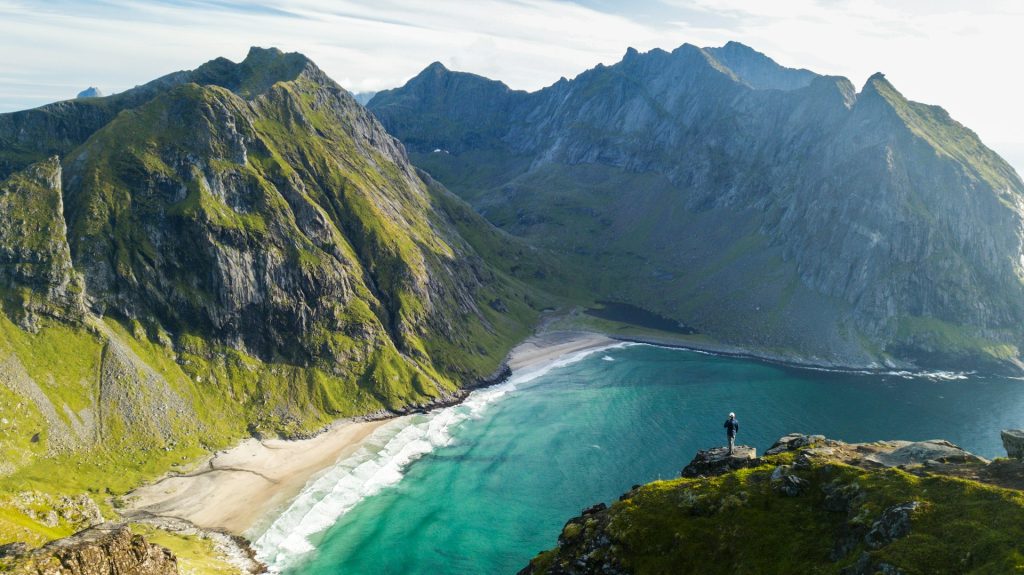
Flying into Lofoten (fastest)
The two main airports in Lofoten are Leknes (LKN) in the middle of the islands and Svolvær (SVJ) on the eastern side. Flights are short hops on small aircraft from Bodø (BOO), and seasonal connections can shift, but Bodø is the reliable gateway year-round. Evenes/Harstad–Narvik (EVE) on the mainland is a larger airport with wider connections; from there you reach Lofoten by road.
Why choose this: It’s the speediest way into the islands and ideal if you have a tight schedule, are visiting in winter when ferries can be weather-affected, or you just want to land close to your accommodation.
How it works in practice
- Fly to Oslo (OSL) or another European hub.
- Connect to Bodø or Evenes.
- From Bodø, take a short flight to Leknes or Svolvær. From Evenes, continue by bus or rental car into Lofoten.
Local tip: If your final stop is around Reine, Hamnøy, or Sørvågen, Leknes puts you closer. If you’ll base in Henningsvær or Svolvær, flying to SVJ saves time on the ground.
Baggage and aircraft note: The small regional planes have stricter carry-on limits. Pack a soft-sided bag if you can and keep essentials handy in case of tight turnarounds.
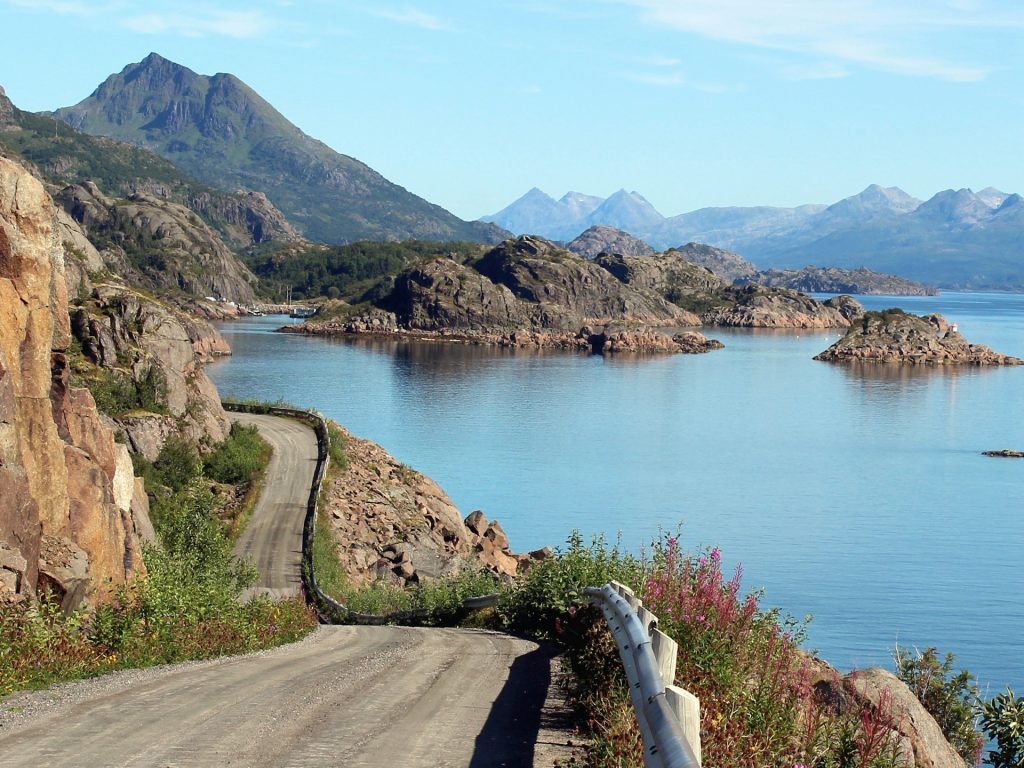
Ferry routes to Lofoten (scenic and flexible)
Ferries are more than transport up here; they’re part of the landscape. The two most useful for visitors are:
Bodø–Moskenes (car and passenger ferry)
This is the classic Lofoten arrival. You sail straight into the dramatic west side, minutes from Reine and Å. Crossing times and frequencies vary by season. Advance reservations for cars in summer are critical. Foot passengers usually have space but still arrive early in July and August.
Melbu–Fiskebøl (car and passenger ferry)
Shorter and useful if you’re approaching from Vesterålen or want to do a loop: mainland–Vesterålen–Lofoten–mainland. It’s a great way to combine whale-watching in Andenes with time in Lofoten.
Other connections to know
- Lødingen–Bognes (car ferry): on the E10 corridor between the mainland and the Lofoten/Vesterålen region. It’s handy when driving up from the south without going via Narvik.
- Røst and Værøy: The Bodø–Moskenes line also serves Røst and Værøy on some departures. Beautiful detours if you like bird cliffs and quiet fishing communities.
Local tip: Plan your arrival in daylight if possible. The last hour into Moskenes is a show and it’s much easier finding your rorbu and navigating narrow roads with daylight on your side.
Express boats (hurtigbåt) from Bodø
The Bodø–Svolvær express boat is a passenger-only catamaran that threads the skerries and stops at Skrova on some departures. It’s the sweet spot between speed and scenery if you’re without a car. You land in Svolvær, with buses onward to places like Henningsvær, Leknes, and Reine.
Why choose this: You’re traveling light, want to avoid potential car-ferry queues, and prefer a smoother crossing than the open-sea Moskenes route can sometimes deliver.
Seat strategy: The boat is popular in high season. Arrive a bit early for boarding and bring layers; the wind on deck is no joke even in July.
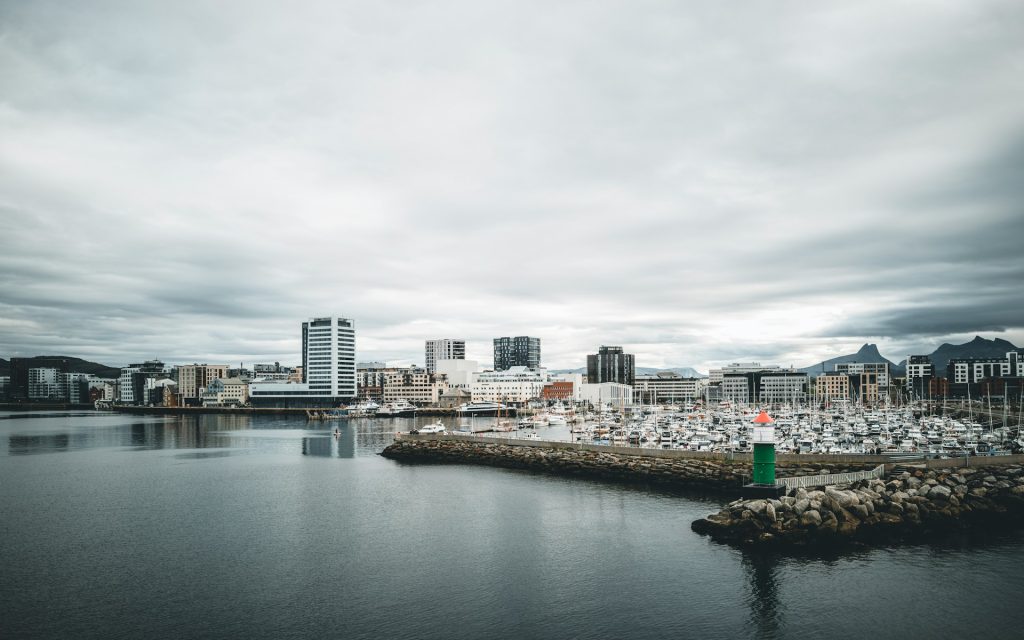
Train plus bus: slow travel done right
If you enjoy rail journeys, there are two classic lines that put you within striking distance:
Nordland Line: Trondheim–Bodø
An overnight or full-day ride through forests, lakes, and subarctic plateau. From Bodø, connect by ferry or flight into Lofoten. This is the most seamless rail-to-island combination.
Ofoten Line: Sweden–Narvik
Narvik is on the mainland north of Lofoten. From Narvik, it’s a bus journey along the E10 to Svolvær and beyond. The scenery between Narvik and Lofoten is underrated: sharp fjords, eagle country, and long bridges arching over green water.
Local tip: If you’re rail fans, build an itinerary that arrives by Bodø ferry and departs via Narvik bus, or vice versa. You’ll experience both sides of the archipelago and avoid backtracking.
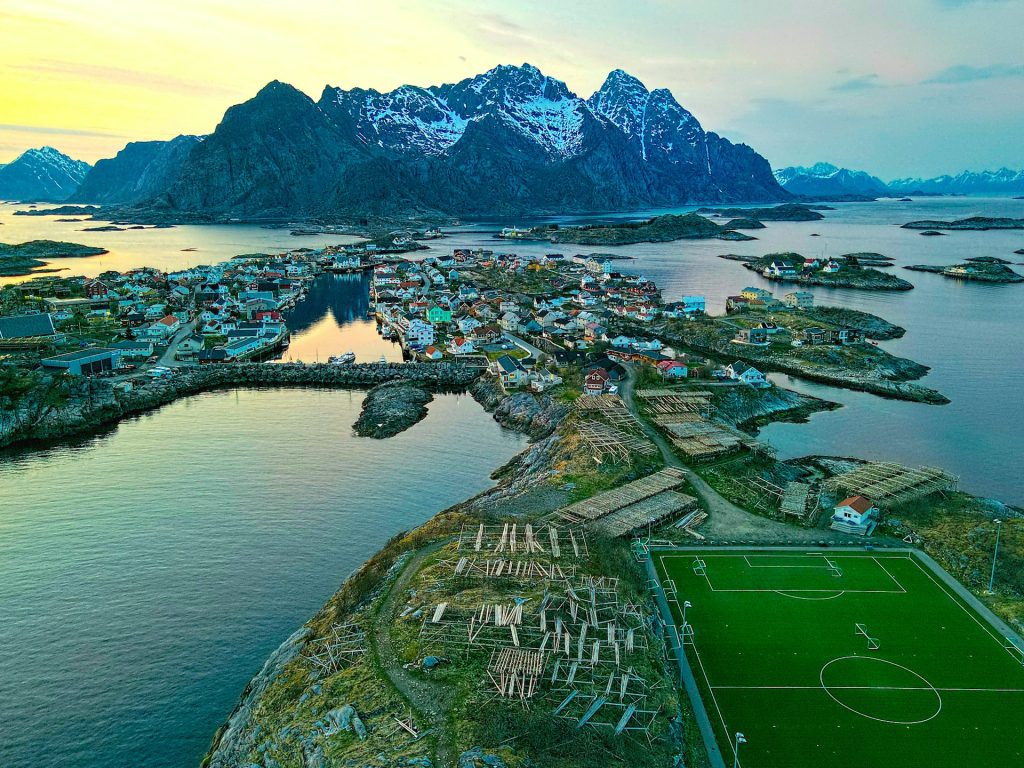
Driving to Lofoten: freedom on four wheels
E10 is the spine of Lofoten, running all the way from the mainland to Å i Lofoten. Driving gives you maximum flexibility for photo stops, side hikes, and chasing the midnight sun or northern lights.
Approach options
- From the south: Drive E6 north and either take the Bognes–Lødingen ferry to join E10, or continue to Bjerkvik and turn onto E10 without a ferry. The no-ferry route is longer in kilometers but can be faster in peak ferry queues.
- From the north (Tromsø/Alta): Join E6 to Bjerkvik and then E10 west to Lofoten.
- From Bodø: Put the car on the Bodø–Moskenes ferry and start directly in the dramatic western islands.
Winter driving reality: November through April can bring snow, ice, and sudden weather. Norway requires season-appropriate tires. On rental cars that means studless winter tires most places; studded tires are common in the north and worth the upgrade if you expect storms. Slow down on frost-polished corners, avoid night arrivals in heavy snow, and check road warnings before setting off.
Parking culture: Respect signed parking and private land. Small villages like Hamnøy and Sakrisøy are gorgeous but tight; use designated lots even if it means a 5–10 minute walk.
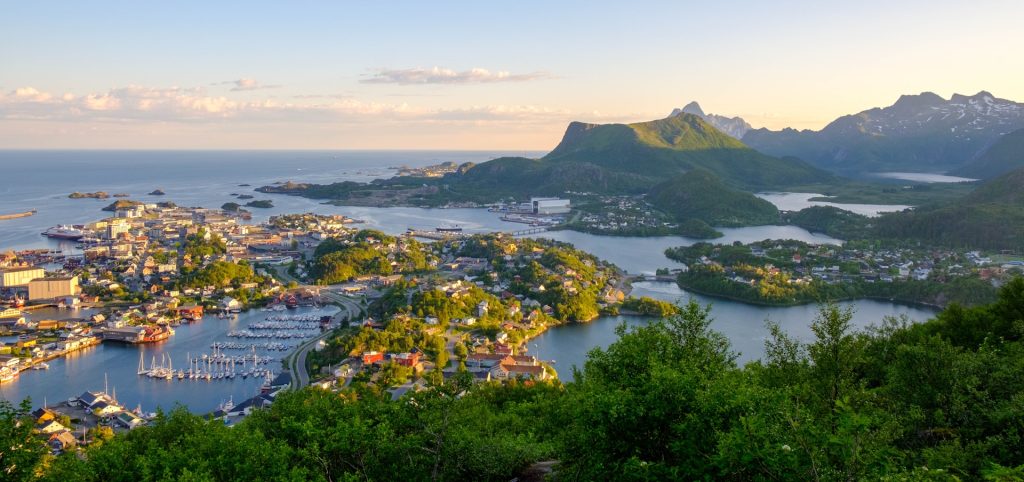
Buses inside Lofoten and regional coaches
Public transport on Lofoten is reliable but not frequent. Expect a handful of buses per day on main corridors such as Å–Reine–Leknes–Svolvær with reduced service on Sundays and holidays. If you’re basing in one spot and planning a couple of big hikes or photo days, buses can work. If you want to roam freely, rent a car.
Airport coaches and regional lines
- Evenes (EVE) to Svolvær/Leknes: Airport coaches meet many flights and continue along E10 into the islands. Good value if you’re traveling solo and staying near the route.
- Narvik–Lofoten: Regular through-buses along E10 connect Narvik with Svolvær and beyond.
- Bodø–Moskenes–Lofoten: In summer, buses meet some ferry arrivals at Moskenes for onward travel to Reine, Ramberg, Leknes.
Local tip: If you rely on buses, plan your day backward from your last bus home. It keeps you from getting stranded with a sunset you can’t watch because you’re sprinting to a stop.
Choosing the best route by season and travel style
Summer (June–August):
Daylight nearly around the clock, lots of traffic, and very high demand on car rentals and ferries. Book cars and ferry lanes early. Flying into Leknes or Svolvær is efficient; otherwise, Bodø–Moskenes ferry plus a car works beautifully. The express boat to Svolvær is a great foot-passenger choice.
Autumn (September–October):
Weather shifts daily, but seas are often calmer than winter and the light is unreal. Ferries are less crowded; you can be more spontaneous. Consider flying to Evenes and driving in for flexibility with changing forecasts.
Winter (November–March):
Short days, slick roads, and the northern lights. Fly as close as you can to reduce long driving in the dark. If you do drive, allocate extra time and use winter-ready cars. Ferries operate year-round but can be delayed by storms.
Spring (April–May):
Snow lingers on peaks; roads clear up; prices are kinder. A balanced time for Bodø–Moskenes arrivals or Evenes fly-and-drive.
Travel style matchups
- Photographers and hikers: Ferry to Moskenes or fly to Leknes to be close to Reinebringen, Kvalvika, Ryten. Having a car helps you hit sunrise lines and dodge clouds.
- Food and village wanderers: Svolvær, Kabelvåg, and Henningsvær make a relaxed base. Fly to Svolvær or arrive by express boat.
- Budget travelers without a car: Train to Bodø, express boat to Svolvær, then stitch days with buses and targeted taxi rides.
- Families: Fly to Evenes and drive; it’s smoother with luggage and car seats, with supermarkets and bigger shops en route before you branch into the islands.
Car rental, campervans, and bikes
Car rental: In high season the islands do run out of cars. If prices look wild, check Bodø; sometimes renting there and ferrying across is cheaper. Automatics cost more and sell out first.
Campervans: Fantastic way to roam, but follow local rules. Use official campervan sites and service points, and avoid “wild camping” in signed no-camping zones or sensitive areas. Empty gray water only at proper stations.
Cycling: Lofoten is doable by bike if you’re fit and comfortable with narrow roads and occasional tunnels. Wind is the boss. Shoulder seasons are nicer for traffic; summer has more services.
Smart timing and booking habits
- Build a buffer day if you have must-do plans (a booked photo tour, a wedding, a once-in-a-lifetime hike). Weather and ferries sometimes have their own ideas.
- Reserve car-ferry space for Bodø–Moskenes in July and early August, and arrive at the quay early even with a reservation.
- Travel light and modular. Layers, waterproofs, and shoes that can handle a dock puddle make transfers smoother.
- Check weekend/holiday timetables for buses and shops. Norway takes Sundays seriously; plan fueling and groceries accordingly.
Sustainable choices that still feel like a holiday
- Combine regions in one loop rather than multiple long out-and-backs. For example, Bodø–Lofoten–Vesterålen–Narvik. It cuts duplicate driving and shows more variety.
- Use express boats and buses where they make sense; they’re efficient and scenic.
- Stay longer in fewer bases. Lofoten rewards depth: two nights in Reine and three in Svolvær/Henningsvær will show you more soul than five one-night stands.
What I’d pick for different trip lengths
A long weekend (3–4 days):
Fly to Leknes or Svolvær. Rent a car for two full days and one flexible day. Focus on a tight area: either west (Reine, Hamnøy, Ramberg) or east (Henningsvær, Svolvær, Kabelvåg).
A week:
Arrive Bodø–Moskenes by ferry with a car. Spend 3–4 nights in the west and 2–3 nights near Svolvær/Henningsvær. Depart via Evenes to avoid backtracking, or loop back to Bodø if your rental is there.
Ten days or more:
Add Værøy or Røst for a remote-island feel, or continue to Vesterålen for whale safaris and softer landscapes. Finish in Narvik for the train story or back in Bodø for good coffee and a final harbor walk.
Frequently asked practicals
Do I need a car?
Not strictly, but a car gives you the most Lofoten for your time. Without one, cluster your sights and use the express boat and buses smartly.
Will I get seasick?
Open-ocean days on the Bodø–Moskenes ferry can be lively. If you’re sensitive, bring tablets, sit midship, and consider the express boat or Evenes road route on stormy forecasts.
Is winter a bad idea?
It’s magical if you’re flexible. Keep driving distances short, use daylight for travel, and prioritize direct flights to Lofoten or Evenes to avoid long night drives.
What about phone coverage and payments?
Coverage is good along E10 and in villages. Cards are king in Norway; keep a little cash, but you’ll rarely need it.
Getting to Lofoten can be simple or cinematic depending on your choices. Pick the route that matches your season, your patience for boats and buses, and the kind of memories you want to carry home. Either way, that first glimpse of mountains dropping into the sea will tell you it was worth the logistics.